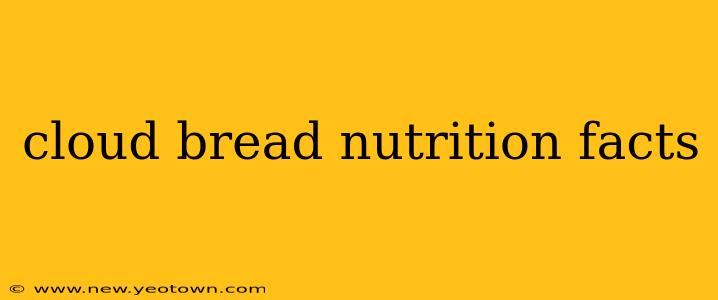Cloud bread, that airy, ethereal creation that resembles a fluffy cloud more than a bread, has taken the low-carb world by storm. Its light texture and surprisingly satisfying taste make it a popular alternative to traditional bread for those following ketogenic or low-carb diets. But what exactly is the nutritional breakdown of this culinary curiosity? Let's dive into the cloud bread nutrition facts and explore some frequently asked questions.
What are the main ingredients in cloud bread?
The magic of cloud bread lies in its simplicity. The core ingredients are just eggs and cream of tartar. That's it! The cream of tartar acts as a stabilizer, helping the egg whites whip up into a light and airy meringue. Some recipes might add a touch of cream cheese or other flavors, but the foundation always remains these two simple components. This simplicity contributes to its overall nutritional profile.
How many calories are in a cloud bread roll?
The calorie count per cloud bread "roll" varies depending on the recipe and size. However, a typical serving (approximately 3-inch diameter) generally contains around 30-40 calories. This low calorie count is one of the main appeals for those watching their weight. The minimal ingredient list contributes to this low calorie count.
What is the macronutrient breakdown of cloud bread?
Cloud bread is predominantly protein and fat, with minimal carbohydrates. A typical serving will provide roughly:
- Protein: 3-4 grams. The eggs are the primary source of protein.
- Fat: 2-3 grams. The amount of fat will depend on whether you add any additional ingredients like cream cheese.
- Carbohydrates: 1-2 grams. This incredibly low carb content is a significant reason for its popularity among low-carb dieters. The minimal carbs primarily come from the eggs themselves.
Is cloud bread gluten-free?
Yes, cloud bread is naturally gluten-free. Since it contains only eggs and cream of tartar, there are no gluten-containing ingredients. This makes it a suitable option for those with celiac disease or gluten intolerance.
Is cloud bread keto-friendly?
Absolutely! With its extremely low carbohydrate content and relatively high fat and protein, cloud bread is a perfect fit for a ketogenic diet. Its fluffy texture offers a satisfactory bread alternative without derailing your keto macros.
Does cloud bread contain any vitamins and minerals?
While not a significant source of vitamins and minerals compared to other foods, cloud bread does provide some nutrients. The eggs contribute to a small amount of vitamins like Vitamin D, Vitamin B12, and choline, along with minerals like selenium and iodine. However, it's not a primary source for these nutrients and shouldn't be relied upon as such.
How does cloud bread compare nutritionally to regular bread?
The difference is quite stark. Regular bread is significantly higher in carbohydrates, often containing refined grains and added sugars. Cloud bread, on the other hand, is incredibly low in carbohydrates, while also providing a good source of protein. The comparison highlights its appeal to those looking for low-carb or high-protein alternatives.
Can I add other ingredients to cloud bread to increase its nutritional value?
Yes! While the basic recipe is simple, you can enhance cloud bread's nutritional profile by incorporating ingredients like:
- Added vegetables: Pureed vegetables like zucchini or spinach can be added to the batter, boosting the vitamin and mineral content.
- Seeds: Adding chia seeds or flax seeds can increase the fiber and omega-3 fatty acid content.
- Spices: Incorporating spices like garlic powder or onion powder adds flavor and antioxidants.
Remember, cloud bread should be considered a complement to a balanced diet, not a standalone nutritional powerhouse. While it offers several advantages in terms of low-carb and high-protein content, it's important to eat a varied and nutritious diet for overall health.

